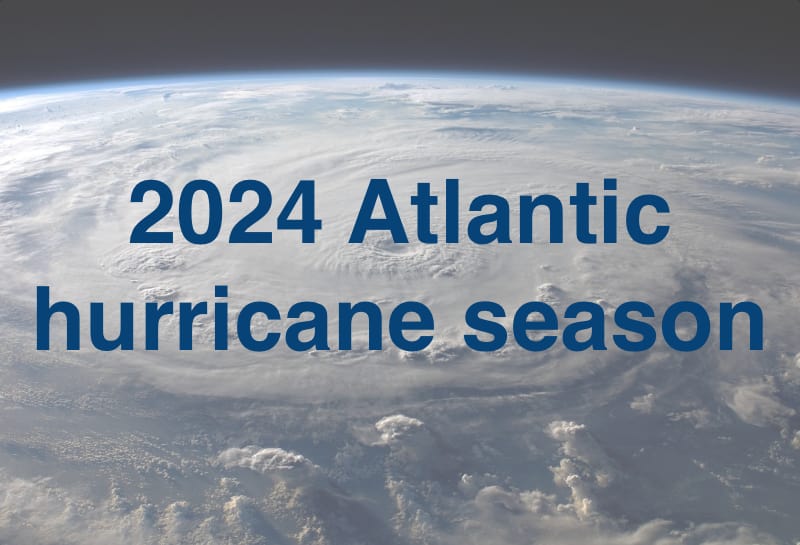NOAA & CSU reduce named storm numbers, but keep hurricane forecast high

US weather service NOAA and the Colorado State University (CSU) tropical meteorology team have updated their forecasts for the 2024 Atlantic hurricane season and while they have reduced slightly the number of named storms expected, overall the forecast still calls for a very active hurricane season this year.
Back in May, NOAA forecast that that between 17 and 25 named tropical storms would form this season, which it has now reduced to between 17 and 24.
It seems a very slight adjustment that may simply be to account for the passage of time so far this season, while this updated forecast does include all activity seen to-date in 2024.
NOAA continues to forecast that the Atlantic basin will see between 8 and 13 hurricanes and 4 to 7 major hurricanes this year.
It also has updated its forecast for accumulated cyclone energy (ACE) for the season, which had been in a range from 150% to 245% of norm back in May, to now 165% to 245% of norm, with the low-end coming up because of the ACE generated by Beryl it seems.
A typical hurricane season only sees 14 named storms, so the forecast remains for a particularly active one in 2024.
NOAA believes there is a 90% chance of an above-normal 2024 Atlantic hurricane season, with just a 10% chance activity is below normal.
Matthew Rosencrans, lead hurricane season forecaster with NOAA’s Climate Prediction Center commented, “We’re continuing to see the climatological hallmarks of an active season.”
Adding that, “Sea surface temperatures remain abnormally high, and La Nina is still expected to emerge during the hurricane season, so the time to prepare is now.”
However, the forecasts for La Nina conditions have been tempered by some meteorologists and expectations it could emerge in the middle of the hurricane season now appear to be pushing towards the latter stages.
NOAA’s own Climate Prediction Center has acknowledged that La Nina appears to have been delayed slightly, but still sees a 66% chance this climate pattern will emerge sometime during the months of September to November.
Meanwhile, the Colorado State University (CSU) forecast team has reduced the number of named tropical storms expected by 2, from 25 in their last forecast update, to now 23 for the entire season including activity seen to-date.
The CSU forecast for hurricanes remains 12 and major hurricanes 6, while ACE is forecast to reach an index level of 230 for the season.
The way La Nina is referred to has changed slightly, with a less explicit call for it to form during the hurricane season.
The CSU team now states, “We have maintained our forecast for an extremely active Atlantic hurricane season in 2024. We have reduced our forecast number of named storms slightly but have maintained all other numbers from our July update. Sea surface temperatures averaged across the hurricane Main Development Region of the tropical Atlantic and Caribbean remain near record warm levels. Extremely warm sea surface temperatures provide a much more conducive dynamic and thermodynamic environment for hurricane formation and intensification. We continue to anticipate cool neutral ENSO (El Niño Southern Oscillation) or La Niña during the peak of the Atlantic hurricane season, resulting in reduced levels of tropical Atlantic vertical wind shear. This forecast is of above-normal confidence.”
So there is no longer quite such an explicit call for La Nina to emerge during the peak hurricane season, which some may view as potentially good news as conditions may not become quite as conducive for hurricanes as they would otherwise had La Nina come racing in by or around the seasonal peak.
But, the CSU team caution, “We anticipate a well above-average probability for major hurricane landfalls along the continental United States coastline and in the Caribbean.”
Which is really what matters to the catastrophe bond, ILS and reinsurance industry.
The adjustment down to storm numbers seem due to the passage of time, while conditions are still seen as extremely conducive to storm intensification.
The timing of La Nina, while important, does not have a bearing on a hurricane making landfall in a populated region with high insured exposure density, which is really what the industry is watching for during the season.
The Atlantic tropics are expected to fire into action again with tropical storm Ernesto expected to be named in the next day or two, then head to the Antilles and onwards on a track that currently the forecast models show curving north into the Atlantic.
In fact, some forecast models suggest a future hurricane Ernesto could get close to Bermuda, so we’d urge our friends and partners based there to keep one eye on the forecasts as they develop over the next few days.
Incorporating the latest updated forecast figures alongside those others we track, makes no change to our Artemis Average forecast for the 2024 hurricane season, of 23 named storms, 12 hurricanes and 5 major hurricanes.
Track the 2024 Atlantic tropical storm and hurricane season on our dedicated page and we’ll update you as new information emerges.






